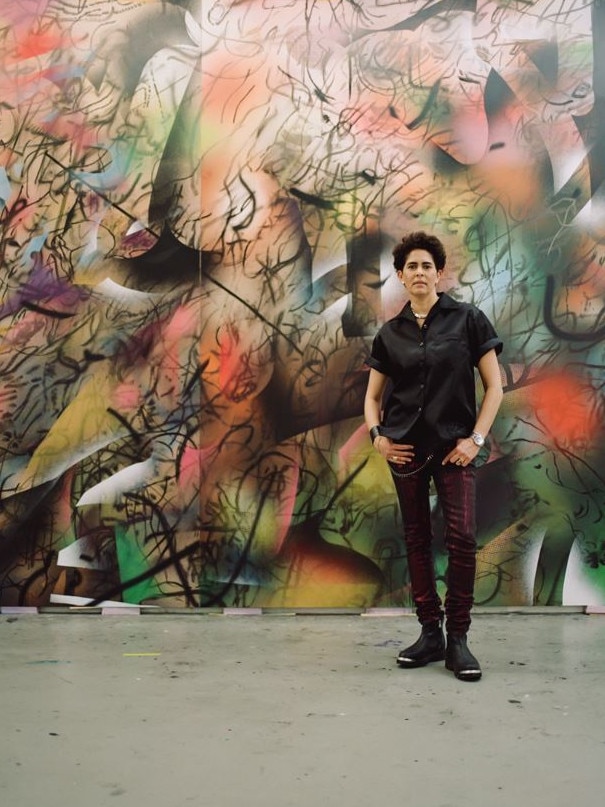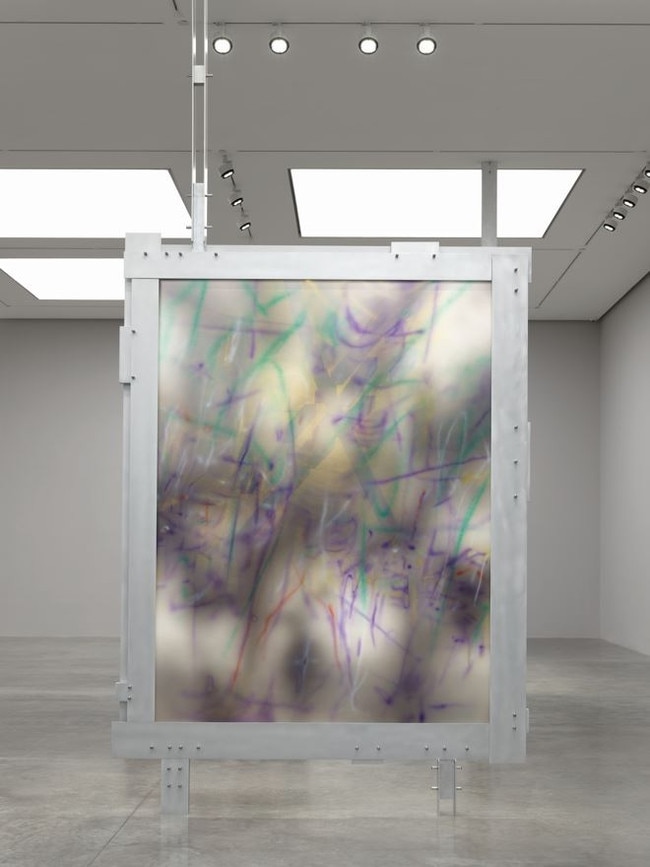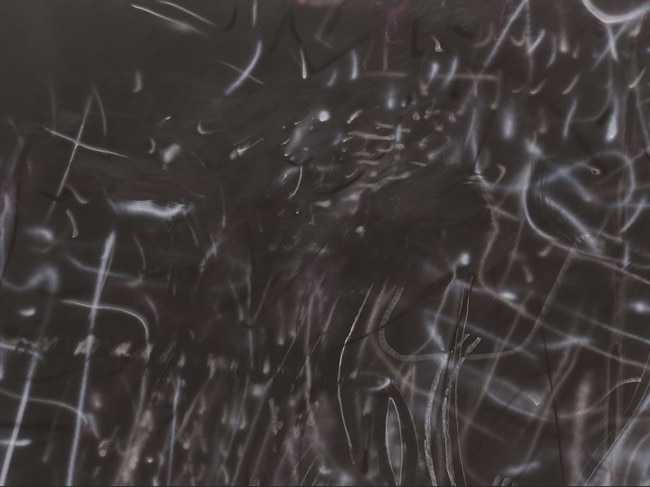Julie Mehretu brings her first Australian solo exhibition to Sydney this month
Time Magazine named her one of today’s most influential artists for redefining the craft. Now Australians will get the immersive and intense Julie Mehretu experience for themselves.

Viewing the work of American artist Julie Mehretu is an immersive and intense experience. Her drawings, prints and large-scale abstract paintings are alive with intricately layered marks, lines and symbols. Gazing at them creates a sense of being pulled into the composition, where amid the seeming chaos, patterns and rhythms begin to emerge.
For Mehretu, this interplay between her work and the observer is, in part, what drew her to this nonrepresentational style. “There’s this kind of possibility available in abstraction that I find really intriguing,” she says. “In the space of searching and trying to find liberatory places in art-making, abstraction allows for a more experiential kind of dynamic with the viewer, one that is less instructive.”


Mehretu was born in 1970 in Addis Ababa, Ethiopia, to an American mother and Ethiopian father. Aged seven, she escaped the country’s ongoing civil wars, moving with her family to Michigan. Those early experiences of displacement – “all of a sudden, I had a different kind of understanding of selfhood, of my family, of who we are, where we are” – shaped her inquiring mind and a questioning of her place in the world, an ongoing thread in her work.
Now based in New York, the artist is currently in the final stages of preparing for her visit to Sydney this month for the opening of her show at the city’s Museum of Contemporary Art (MCA), part of the gallery’s Sydney International Art Series. Sydney is a city the artist knows well; Mehretu was married to Australian artist Jessica Rankin, with whom she shares two children. “She’s a co-parent with me and we’re very close – both our children have Australian passports and go back regularly,” she shares.
Her upcoming show, the first major solo exhibition of her work in the Southern Hemisphere, is a significant event on the local culture calendar, allowing Australian audiences the rare opportunity to experience her powerful work firsthand. Though Mehretu has shown in Australia before – a collaborative installation was included in the MCA’s 2006 Biennale – she’s since become recognised internationally as one of the most significant artists of our time, and was named one of the Top 100 Most Influential People of 2020 by Time magazine. This year, the New York Times described her as “one of today’s most original and thought-provoking painters”.
It’s hard to fathom that Mehretu wasn’t even sure she would pursue art as a career when she was younger. “Coming from the Midwest, I didn’t really think that was something that one could do,” she reflects. “It was a very different time, and you didn’t have the kind of contemporary art spaces that you do now.” Yet art was constant in her life since childhood. That it became her vocation seemed inevitable. “Even when I went to university, it was something I wasn’t sure I would focus on, but it became my major because it’s what I always did,” she says.
Mehretu went on to earn an arts degree from Kalamazoo College in Michigan, followed by a masters in fine arts at the prestigious Rhode Island School of Design. “Graduate school really was this moment where I started to interrogate ideas around painting and printmaking,” she says. “In that space, there was this kind of reluctance to work with representational language, and part of that was its definitiveness.” Her investment in abstraction took root, the artist weaving stories through paintings without relying on representations of people or places, but instead constructing elaborate landscapes filled with sweeping lines, geometric shapes and dynamic marks bursting with energy.

Mining her own experiences in her work, Mehretu also reveals a deep curiosity about space and place. She explores themes of urbanisation, globalisation, history, climate change and migration, often reflecting on the chaos and conflict of contemporary life and challenging people to consider the intersections of space, time and human experience. How, we are compelled to ask, does history, culture and politics shape our world? “I’m most interested in the kind of experience where a viewer comes to the work and hopefully that work is able to create a visceral and somatic experience with them that is transformative in some way or another, whether it’s cerebral, or whether it’s felt, or whether it’s a memory,” she says.
Suzanne Cotter, MCA director and curator of the exhibition, believes visitors will encounter some of the most exciting paintings they will ever see during the Sydney survey. “It’s big, it’s bold, it’s abstract, rich, multilayered and technically experimental,” she enthuses. “You can really get a sense of the artist making the work and can feel it’s something that’s been intuitively pulled together and constructed, so it feels very dynamic. It’s an experience of painting like no other.”
More than 80 paintings and works on paper dating from 1995 to the present, plus new works she’s creating especially for the presentation, will be included. Paintings from the past five years or so are the focus, but her earlier drawings, which use the architectural as a social framework, provide context. “The works on paper act as a visual and conceptual spine to the exhibition because they run through the work,” explains Cotter. “They offer an insight into what informs the paintings.”
Mehretu’s more recent paintings, the stars of the show, were triggered by seismic world events such as Black Lives Matter, the global pandemic, 2021’s US Capitol insurrection and Russia’s invasion of Ukraine in 2022. Her current work also draws on photography as a tool in her creative process, projecting blurred or distorted images related to historical events or political protests onto her canvas, then layering her own markings over the top – the photographs’ presence an undercurrent in the pieces, a tension created between what’s visible and what’s concealed.

Given their vast scale and complexity, Mehretu sometimes requires a crane to reach her canvas, and the pieces can take years to complete. Much time is invested in the preparatory stages – with projected images traced with layers, sometimes up to 15, of markings and shapes, masked with tape, painted, air-brushed or drawn, translating the original source onto canvas – before she starts painting on top. “The under paintings really take time, and the most laborious part that takes the longest time is the surfacing,” she explains.
Last year, Cotter saw some of the pieces that will hang inside the MCA at the artist’s solo show at London’s White Cube gallery. “I walked into that exhibition and it was breathtaking,” she remembers. “It’s not just the scale of the paintings, it’s not just the energy, it’s the way she uses colour, the way she uses lines and the way she arranges them, and the paintings’ relationship to one another.”
Among the highlights in Sydney is a series of nine paintings titled Femenine in nine (2023), where black canvases are marked with iridescent dashes and scrawls, a meditation on the conditions of darkness and instability in the world right now. In the TRANSpaintings series (2023-24), the mesmerising works hang free from the wall, set within sculptural supports by Berlin-based artist Nairy Baghramian. Viewable from both sides and transparent – so you can see people moving about on either side – they are an invitation to deep dive into their beauty, and to ponder the artist’s process.
“What I really became kind of excited about and intrigued by is the kind of mutability of those paintings, depending on how many people are in a room looking at them, who’s in front, what colours they’re wearing, where you are in relation to the front of the back of them,” notes Mehretu. “All of that combined pushes even further some of these ideas of how one experiences the painting, where the painting is in relation to one’s being and what type of presence that painting has.”
Several new transparent paintings are in progress for Sydney. Her hope is that her work will resonate with local audiences, tapping into the fact we are all part of an increasingly interconnected world and searching for our place in it. “We’re all in the space, globally, of interrogating new ways of being, and part of that is really grounded in old ways,” she says thoughtfully. “We’re exploring and negotiating, mining that stuff, and I think that is what’s also happening in the paintings.”
Cotter’s description of “entering into a theatre of paintings”, eloquently sums up the wonder of the world Mehretu creates. In bringing our own interpretations to her abstract works, each viewing experience is personal and unique, yet we are also part of the ensemble.
Julie Mehretu: A Transcore of the Radical Imaginatory is on at the MCA from November 29 until April 27, 2025.
This story is from the November issue of Vogue Magazine, on sale now.



To join the conversation, please log in. Don't have an account? Register
Join the conversation, you are commenting as Logout